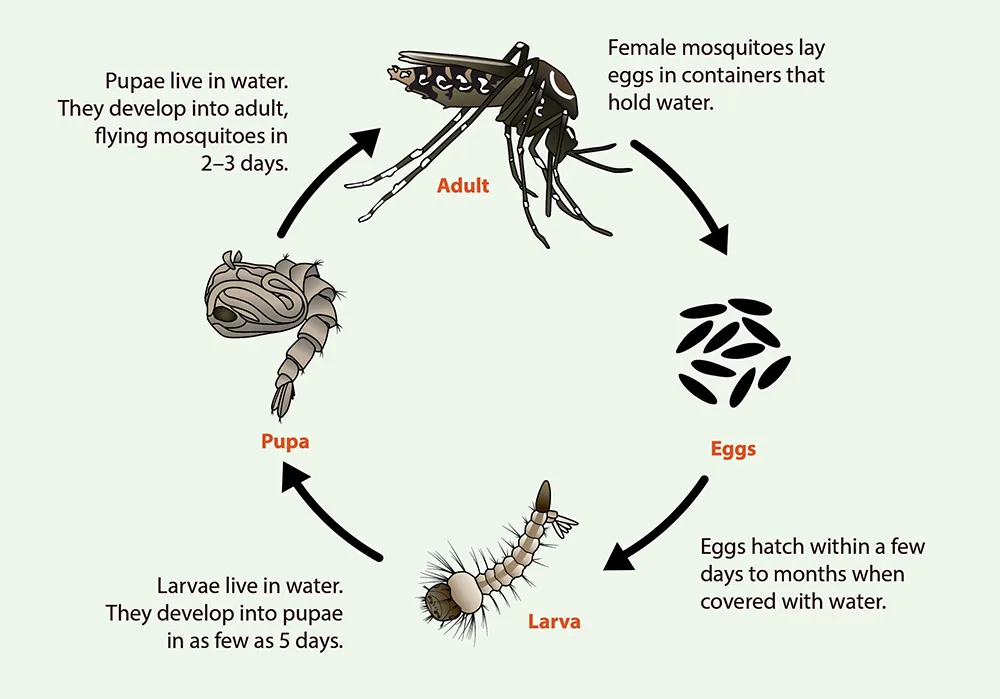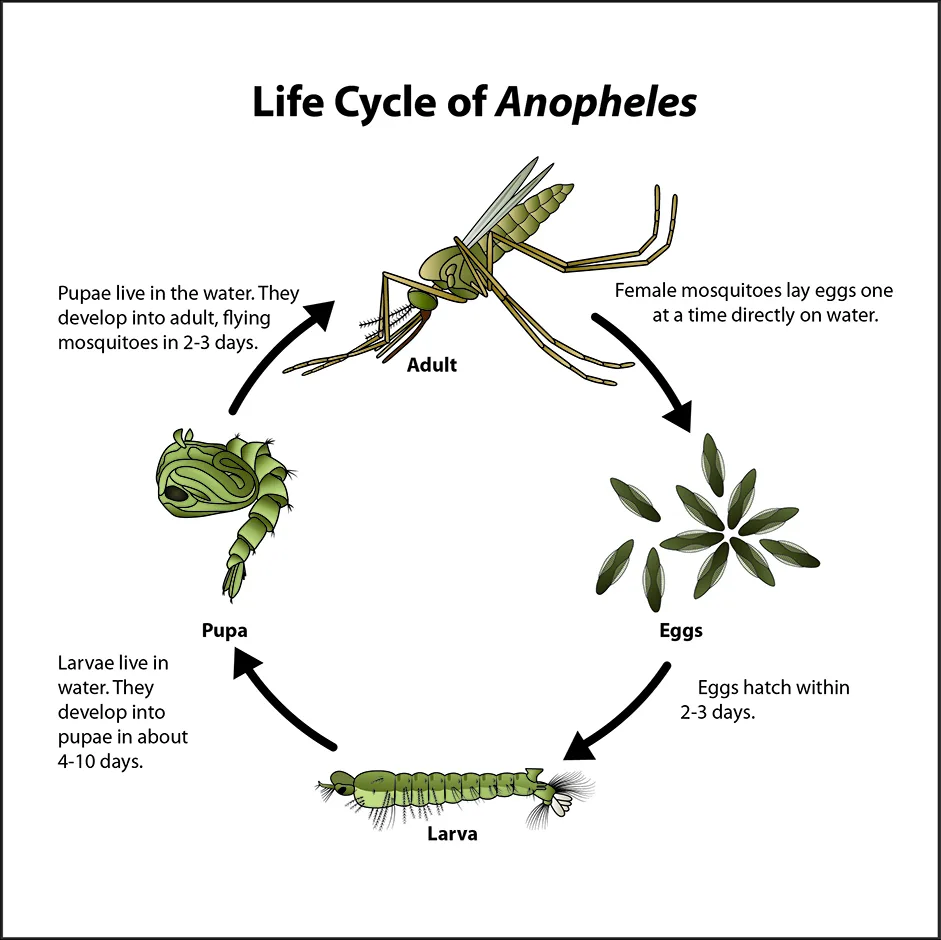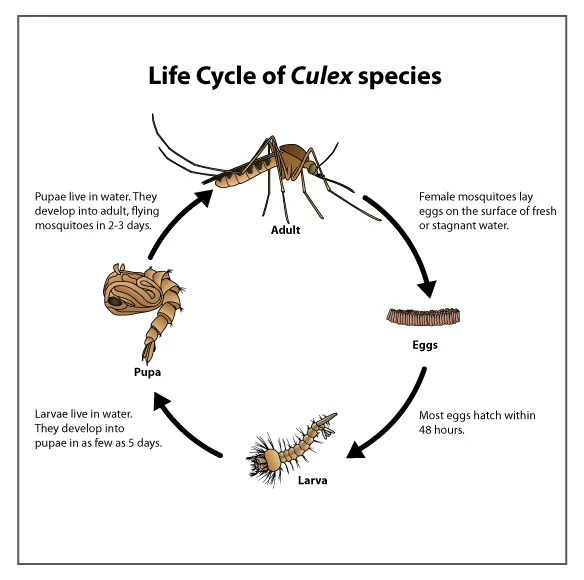Mosquitoes are small, flying insects that belong to the Culicidae family. They have long, thin legs, a narrow body, and a pair of wings. Mosquitoes are known for their ability to transmit diseases, such as malaria, dengue fever, and Zika virus, through their bites. They are attracted to humans by the carbon dioxide we exhale, as well as by certain chemicals in our sweat and body odor. Mosquitoes breed in stagnant water, laying their eggs on the surface of the water. The larvae hatch and develop in the water, eventually pupating and emerging as adult mosquitoes. There are many species of mosquitoes around the world, and they are found in a variety of habitats, including forests, grasslands, and urban areas. Explore the lifecycle of mosquito, differences between Aedes, Anopheles, and Culex, and learn about male and female mosquitoes.
Classification
- Kingdom: Animalia
- Phylum: Arthropoda
- Class: Insecta
- Order: Diptera
- Family: Culicidae
There are thousands of species of mosquitoes found around the world, but some of the most common species include:
- Aedes aegypti: also known as the yellow fever mosquito, is a common vector for diseases such as dengue fever, chikungunya, and Zika virus. It’s commonly found in urban and suburban areas and is particularly attracted to humans.
- Anopheles gambiae: is a species of mosquito that is a major carrier of the malaria parasite in sub-Saharan Africa. They are typically found near water sources like swamps, ponds, and rivers.
- Culex pipiens: is a species of mosquito found throughout the world that is a vector for diseases such as West Nile virus and filariasis. They are typically found near standing water sources like bird baths and rain gutters.
- Aedes albopictus: is also known as the Asian tiger mosquito and is a vector for diseases such as dengue fever and Zika virus. These are particularly aggressive during the daytime.
- Anopheles quadrimaculatus: is a species of mosquito found in North America that is a vector for malaria in the southern United States.
- Culiseta melanura: This species is found in the eastern United States and is known for transmitting Eastern equine encephalitis. They are typically found in wooded areas near swampy habitats.
These are just a few examples of the many species of mosquitoes that exist around the world.
Lifecycle of Mosquito

1. Egg
During the egg stage of a life cycle of mosquito, the following points are important to note:
- Adult, female mosquitoes seek out containers of standing water to lay their eggs. These containers include bowls, cups, fountains, tires, barrels, vases, and any other container that can hold water.
- The eggs are laid on the inner, wet walls of the container above the waterline, either individually or in attached groups called rafts.
- Different species of mosquitoes have different egg-laying habits. For example, Culex and Culiseta species lay their eggs in rafts of up to 200, while Anopheles, Ochlerotatus, and Aedes lay their eggs singly.
- The eggs are very hardy and can survive drying out for up to eight months. They stick to the walls of the container like glue, and some can even withstand subzero winters before hatching.
- Depending on the species and temperature, most eggs hatch into larvae within 48 hours of being laid. However, if the egg is laid out of water and subject to intermittent flooding, the embryo may remain dormant for several years until the ideal hatching conditions are met.
- Water is a necessary part of their habitat, and the eggs are placed directly on the surface of still water, along its edges, in treeholes, or in other areas that are prone to flooding from rain, irrigation, or flooding.
- Some species of mosquitoes overwinter in the egg stage, while others may overwinter as larvae or adults.
2. Larva
The egg stage of life cycle of mosquito is followed by the larval stage, which involves the following points:
- When the water level rises to cover the eggs, larvae emerge from mosquito eggs. This can be triggered by rainwater or humans adding water to containers with eggs.
- The larvae live in the water and come to the surface to breathe. Most larvae have siphon tubes for breathing and hang upside down from the water surface, while Anopheles larvae lie parallel to the water surface to get a supply of oxygen through a breathing opening. Coquillettidia and Mansonia larvae attach to plants to obtain their air supply.
- Larvae shed their skins four times, growing larger after each molt. They feed on microorganisms and organic matter in the water.
- After molting three times, the larva becomes a pupa. During the fourth molt, the larva changes into a pupa.
3. Pupa
After the larva molts for the fourth time, it becomes a pupa. It is the third stage in lifecycle of mosquito.
- Pupae are a non-feeding stage of mosquito development but are mobile, reacting to light changes and tumbling towards the bottom or protective areas.
- The pupal stage is when the mosquito undergoes metamorphosis and transforms into an adult, similar to the process in butterflies.
- In Culex species in the southern United States, this transformation takes about two days in the summer.
- Pupae do not feed, but they must still breathe air at the water’s surface and are sensitive to light and other disturbances.
- Pupae employ a rolling or tumbling action to escape to deeper water, earning them the nickname “tumblers”.
- The pupal stage lasts from 1.5 to 4 days, after which the pupal skin splits and the newly formed adult mosquito emerges and rests on the surface of the water.
By the end of the pupal stage, the mosquito has completed its transformation in lifecycle of mosquito and is ready to leave the water and start its life as a flying adult mosquito.
4. Adult
- It is the final stage in lifecycle of mosquito.
- After emerging from the pupal stage, male mosquitoes feed on nectar from flowers and female mosquitoes feed on humans and animals for blood to produce eggs.
- Female mosquitoes will look for water sources to lay more eggs after feeding.
- Aedes aegypti mosquitoes only fly a few blocks during their life and prefer to bite people unlike other species.
- Aedes aegypti mosquitoes prefer to live near people and can be found inside homes, buildings, and businesses where window and door screens are not used or doors are left propped open.
- The newly emerged adult rests on the surface of the water for a short time to allow itself to dry and all its body parts to harden. The wings have to spread out and dry properly before it can fly.
- Blood feeding and mating does not occur for a couple of days after the adults emerge.
- The male adult mosquito will usually emerge first and will linger near the breeding site, waiting for the females. Mating occurs quickly after emergence due to high adult mortality rates.
- As much as 30% of the adult population can die per day, and females compensate for this by laying large numbers of eggs to assure the continuation of the species.
- Male mosquitoes will live only 6 or 7 days on average, feeding primarily on plant nectar, and do not take blood meals.
- Females with an adequate food supply can live up to 5 months or longer, with the average female life span being about 6 weeks.
- To nourish and develop her eggs, the female usually must take a blood meal in addition to plant nectar. She locates her victims by the carbon dioxide and other trace chemicals exhaled, and the temperature patterns they produce.
- The average female mosquito’s flight range is between 1 and 10 miles, but some species can travel up to 40 miles before taking a blood meal.
- After each blood meal, the female will oviposit (lay) her eggs, completing the life cycle.
- While some species oviposit only once, others may lay eggs several times over the course of their lives.
Difference between Male and Female Mosquito
| Characteristics | Male Mosquito | Female Mosquito |
| Feeding habits | Feeds on nectar from flowers | Feeds on blood from humans and animals to produce eggs |
| Lifespan | Lives for 6-7 days on average | Can live up to 5 months or longer |
| Blood meals | Does not take blood meals | Requires blood meals to nourish and develop eggs |
| Mating | Lingers near breeding site and mates quickly after emergence | Mates after feeding on blood meal |
| Flight range | Flight range is between 1 and 10 miles on average, can travel up to 40 miles | Flight range is between 1 and 10 miles on average |
| Sensitivity to chemicals | Sensitive to chemicals such as carbon dioxide and octenol | Sensitive to chemicals such as carbon dioxide, amino acids, and octenol |
| Egg laying | Does not lay eggs | Lays eggs after taking a blood meal |
| Size | Generally smaller than females | Generally larger than males |
| Behavior | Do not engage in behaviors associated with egg-laying or brood care | Engage in behaviors associated with egg-laying and brood care |


Differences between Aedes, Anopheles, and Culex
| Mosquito Type | Aedes | Anopheles | Culex |
| Appearance | Small, black or dark-colored with white stripes on legs and body | Slender with long legs, brown in color | Small, brown or gray with speckled wings |
| Habitat | Prefer urban areas and breed in standing water found around homes or in containers | Found in rural and suburban areas and breed in clean, freshwater habitats such as ponds and lakes | Common in urban areas and breed in standing water found in catch basins, storm drains, and artificial containers |
| Biting Behavior | Aggressive biters and prefer to bite during the day, especially in the early morning and late afternoon | Bite primarily at night, with peak biting activity at dawn and dusk | Bite at night, with peak biting activity at dawn and dusk |
| Diseases Transmitted | Zika virus, dengue fever, chikungunya, yellow fever | Malaria | West Nile virus, encephalitis, and other arboviruses |
| Resting Position | Rest with their body parallel to the surface they are resting on | Rest with their body at an angle to the surface they are resting on | Rest with their body parallel to the surface they are resting on |
| Flight Range | Fly short distances, typically within 100-500 feet of their breeding site | Fly longer distances, up to several miles | Fly short to moderate distances, typically within 1-3 miles of their breeding site |
References
- https://www.extension.iastate.edu/equine/blog/dr-peggy-m-auwerda/life-cycle-mosquito
- https://www.epa.gov/mosquitocontrol/mosquito-life-cycle
- https://www.vdci.net/mosquito-biology-101-life-cycle/